The Hyginus Camp
Sources
Three Latin versions of De Munitionibus Castrorum are available online at Forum Romanum, IntraText and The Latin Library. There are some significant differences between the texts of the first two and that of the Latin Library. Of the three, The Latin Library text appears to be somewhat incomplete and has more errors. All references will be to the Forum Romanum text; i. e. [21] refers to paragraph 21. The paragraph numbering is consistent in all three of the Latin texts. There is no online English translation available. A translation has been published as: Polybius and Pseudo-Hyginus: The Fortification of the Roman Camp, Translated and edited by M. C. J. Miller and J. G. DeVoto, Ares Publishers, Chicago, 1994. There is also a 1925 unpublished translation by Ian A. Richmond. Both translations give a general idea of Hyginus' camp. The Miller/DeVoto one is far better, but neither is accurate in some important details. [Since this was written, a new edition has been published by Duncan Campbell.] In addition, Alan Richardson has written two articles in the Oxford Journal of Archaeology, 2000 and 2001, in which he develops the mathematical basis for determining the size of the Roman camp. All dimensions are given in Roman pedes. One pes = 0.97 feet, 0.296 meters.The Main Areas of the Hyginian Camp
The general layout of the camp will be given first so that the various elements can be considered within a larger framework. However, many of the aspects of this layout are questionable and will be discussed in later sections when the necessary background material is presented. The first illustration shows the general camp layout with its significant parts.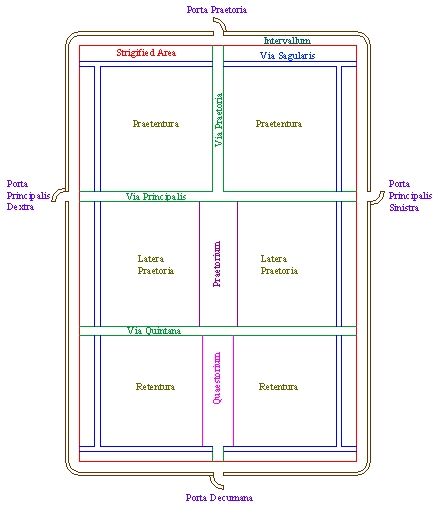 Rampart and Gates: The Fortifications of the camp consisted of a rampart, a protective wall of turf and stakes and a ditch on the outside of the wall. The camp had 4 gates. If there were more than 5 legions in the camp, Hyginus says there were two additional gates added at the ends of the Via Quintana. The Porta Praetoria faced the enemy. Ideally, the ground sloped from the Porta Decumana down to the Porta Praetoria.
Readers who know Latin will have noticed that the right (dextra) and left (sinistra) gates are reversed. This is because Hyginus visualized the camp with the Porta Praetoria at the bottom whereas modern representations always put it at the top. In a similar vein above (supra ) and below (infra ) are also reversed in our frame of reference.
Miller/DeVoto give some alternatives to this particular gate style, but overall, this seems the most likely.
Intervallum: An open area 60 pedes wide between the Strigified Area and the Rampart. [14]
Strigified Area: The area within the camp in which the tents were pitched. The term comes from striga which was a row 60 feet wide within which two lines of tents were pitched. The hemistriga, literally "half-row", but better understood as one side of the row, was 30 feet wide and held one row of tents. It is the term used more often by Hyginus.
Via Sagularis: A narrow street 30 pedes wide which encircled the camp between the outer ring of cohorts and the inner tenting areas. [20]
Main Streets: The Via Praetoria, Via Principalis and Via Quintana were broad avenues providing access to the main gates. The Via Praetoria and the Via Principalis were 60 pedes wide. [14] The Via Quintana was normally 40 pedes wide but was increased to 50 if the camp were large enough to require additional gates at either end of the street.
There are lesser streets referred to. Hyginus sometimes calls them viae vicinariae, other times he does not name them at all. Some were 20 pedes wide, some were only 10.
Praetorium: This was a central area, 720 pedes by between 160 and 220 pedes. [9] In it were to be found the altars, the enshrinement of the army standards, the auguratorium, the tribunal. [11]
Quaestorium: During the Republic, the Quaestor was a magistrate who accompanied the army. Under the empire, the office disappeared but the name persisted. The space was used for prisoners, hostages and plunder. The Quaestorium was narrower than the Praetorium. [18]
Three Parts of Camp: Hyginus identifies three main parts to the camp. The Praetentura was the area between the Via Principalis and the Porta Praetoria. The Latera Praetoria were the areas on either side of the Praetorium. And the Retenturawas the area below the Via Quintana. Hyginus places the valetudinaria (hospital), veterinarium (veterinary hospital) and fabrica (workshops) in the Praetentura. [4] The length of the Praetorium appears to be fixed at 720 pedes. That would imply that changes in the length of the camp would occur in the Praetentura and/or the Retentura.
Rampart and Gates: The Fortifications of the camp consisted of a rampart, a protective wall of turf and stakes and a ditch on the outside of the wall. The camp had 4 gates. If there were more than 5 legions in the camp, Hyginus says there were two additional gates added at the ends of the Via Quintana. The Porta Praetoria faced the enemy. Ideally, the ground sloped from the Porta Decumana down to the Porta Praetoria.
Readers who know Latin will have noticed that the right (dextra) and left (sinistra) gates are reversed. This is because Hyginus visualized the camp with the Porta Praetoria at the bottom whereas modern representations always put it at the top. In a similar vein above (supra ) and below (infra ) are also reversed in our frame of reference.
Miller/DeVoto give some alternatives to this particular gate style, but overall, this seems the most likely.
Intervallum: An open area 60 pedes wide between the Strigified Area and the Rampart. [14]
Strigified Area: The area within the camp in which the tents were pitched. The term comes from striga which was a row 60 feet wide within which two lines of tents were pitched. The hemistriga, literally "half-row", but better understood as one side of the row, was 30 feet wide and held one row of tents. It is the term used more often by Hyginus.
Via Sagularis: A narrow street 30 pedes wide which encircled the camp between the outer ring of cohorts and the inner tenting areas. [20]
Main Streets: The Via Praetoria, Via Principalis and Via Quintana were broad avenues providing access to the main gates. The Via Praetoria and the Via Principalis were 60 pedes wide. [14] The Via Quintana was normally 40 pedes wide but was increased to 50 if the camp were large enough to require additional gates at either end of the street.
There are lesser streets referred to. Hyginus sometimes calls them viae vicinariae, other times he does not name them at all. Some were 20 pedes wide, some were only 10.
Praetorium: This was a central area, 720 pedes by between 160 and 220 pedes. [9] In it were to be found the altars, the enshrinement of the army standards, the auguratorium, the tribunal. [11]
Quaestorium: During the Republic, the Quaestor was a magistrate who accompanied the army. Under the empire, the office disappeared but the name persisted. The space was used for prisoners, hostages and plunder. The Quaestorium was narrower than the Praetorium. [18]
Three Parts of Camp: Hyginus identifies three main parts to the camp. The Praetentura was the area between the Via Principalis and the Porta Praetoria. The Latera Praetoria were the areas on either side of the Praetorium. And the Retenturawas the area below the Via Quintana. Hyginus places the valetudinaria (hospital), veterinarium (veterinary hospital) and fabrica (workshops) in the Praetentura. [4] The length of the Praetorium appears to be fixed at 720 pedes. That would imply that changes in the length of the camp would occur in the Praetentura and/or the Retentura.
General Camp Dimensions
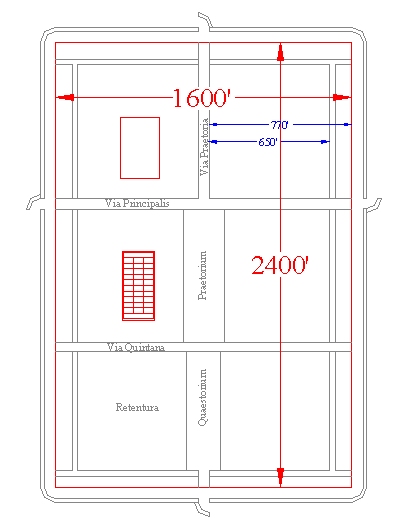 Hyginus gives the overall dimensions of the camp as 2400 X 1600 pedes. [21] Unfortunately, he does not specify precisely how this measurement is made. But, by extrapolating from the information he does provide, it appears that the measure is for the strigified area; that is, the area of the camp that is used for housing the troops. The details of how this is calculated are given later in the section on the praetentura. The strigified area is shown as the red rectangle in the illustration at the right. The intervallum and the camp fortifications are outside of the strigified area.
Hyginus gives the overall dimensions of the camp as 2400 X 1600 pedes. [21] Unfortunately, he does not specify precisely how this measurement is made. But, by extrapolating from the information he does provide, it appears that the measure is for the strigified area; that is, the area of the camp that is used for housing the troops. The details of how this is calculated are given later in the section on the praetentura. The strigified area is shown as the red rectangle in the illustration at the right. The intervallum and the camp fortifications are outside of the strigified area.
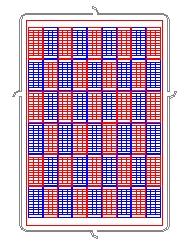 It is difficult to appreciate the size of the camp when it is represented as a small rectangle on a page. To give some sense of scale, two red rectangles have been added. The upper one is a soccer field 100m X 64m. The lower one, with the lines in it, is an American football field, 120 yards long.
Over 50 football fields would fit into the camp, as shown on the left. Many house lots nowadays are 100' X 100', or smaller; the camp would be the size of a large subdivision of some 300-plus homes and streets.
It is difficult to appreciate the size of the camp when it is represented as a small rectangle on a page. To give some sense of scale, two red rectangles have been added. The upper one is a soccer field 100m X 64m. The lower one, with the lines in it, is an American football field, 120 yards long.
Over 50 football fields would fit into the camp, as shown on the left. Many house lots nowadays are 100' X 100', or smaller; the camp would be the size of a large subdivision of some 300-plus homes and streets.
The Fortifications and Intervallum
There are problems with Hyginus' description. His ditch is only 3 pedes deep and 5 wide [49]. A true camp fortification would be at least two or three times as large. This was fully described in an earlier page on the camp. Hyginus says that the width of the intervallum was 60 pedes [14]. But its purpose was to protect the troops from enemy missile fire and also to provide a space inside the protection of the walls in which the army could assemble and manoeuvre. Clearly, 60 feet is insufficient for this purpose. It is generally thought that the intervallum should be closer to 200 pedes wide and that Hyginus simply made a mistake with this measurement. There is one other possibility. In [50] he notes that the fortifications might be 8 pedes wide and 6 deep in a less-secure territory. Perhaps the empire was secure enough that camps well within the borders were no longer seriously fortified. And, if his focus was on the theoretical layout of the units within a camp rather than the fortifications necessary for real defensive measures, then he may possibly have simply described a camp that did not need or have real fortifications. Richardson supports the idea that Hyginus simply erred.The Legionary Cohorts
At the core of the Hyginus camp model is the space allotment to the legionary contubernia, century and cohort.Contubernia
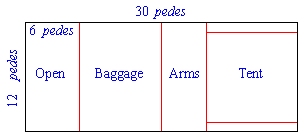 The space given to the contubernia is the least problematic of the descriptions.
The space given to the contubernia is the least problematic of the descriptions.
The tent space is 10 pedes wide for the tent itself plus 2 pedes. The tent holds 8 men. The hemistrigum is 30 pedes deep. Ten pedes are for the tent, 5 for the arms, 9 for the baggage. Since two rows of tents face each other the unused space leaves 12 pedes (6 from each side) for moving around. This space, 12 X 30 pedes, is the core building block of the legionary infantry and, with slight modifications, for the balance of the army as well.Papilio unus occupat pedes X, accipit incrementum tensurae pedes II, tegit homines VIII. . . . Nam quod ad latitudinem hemistrigii pedum XXX attinet, papilioni dantur pedes X, armis pedes V, iumentis pedes IX . . . reliqui pedes XII, qui conversantibus spatio sufficient.[1]
Century
The space allotted to the century is more difficult to understand. In part, it seems straightforward.This seems simple enough. There are 80 men in the century, they have 10 tents and take up 120 feet in length. But within the same paragraph, Hyginus begins to confuse the issue.Plena centuria habet milites LXXX; erunt papiliones X, qui occurunt in longitudine pedum CXX.[1]
Loosely translated: Of them (the 80 men) there will be 4 in each watch so that not more than 8 tents are pitched. Therefore the centurion takes his tenting space in their space, otherwise more space would have to be assigned. This is an awkward sentence to interpret. He appears to say that since there are some men on watch, it is not necessary for the century to use more than eight tents so that the centurion can occupy one of the tent spaces, otherwise more space would be required. The Richmond translation has the number on watch as 16, the Miller/DeVoto book translates it as "4 in individual pickets." Neither interpretation is wholly satisfactory. In vigiliis singulis means in a single watches, or, as we would say it, in each watch. Quaterni means four each, by fours, four at a time, or four together. The Miller/DeVoto translation of 4 men on watch seems to follow the gist of the text, however 80 men less 4 on watch leaves 76 men, but 8 tents of 8 men each can only hold 64 men. Hyginus' method of reducing the number of tents does not work with only 4 men on watch. It does work if 16 men are on watch at any given time, as Richmond translates the passage. However, it is hard to get the number 16 from the text. Later [28] Hyginus applies the same technique of assigning officers their soldiers' unused tent space to other provincial units. He says that a large infantry regiment has 10 centuries and has 100 tents, ex eis centuriones singulis: "out of which the centurions have one each". Clearly, the tents for the centurions come out of the number allotted to the infantry. This is further reinforced in the many paragraphs in which Hyginus discusses the space allotments for the cohort, always in units based on the 120 x 30 pedes of the contubernium and never with an additional spaced added on for the centurion. Nor, in discussing space allotments for other types of units, does he ever add space for the officers, so one must infer that he always uses the same technique to reduce the number of tents. Following this logic, for his army of some 38,730 men [30] there would be 4 on watch for every 80 or so men. That would be some 1,936 men on watch at any one time. In [21] he gives the overall dimensions of the camp as 2400 X 1600 pedes. If all of the men on watch were on the wall they would be spaced one man every 4 pedes. But, of course, they were not all stationed on the wall, for there were units on guard within the camp itself. 2,000 men on guard duty for the whole seems roughly reasonable. For Hyginus' space reduction scheme to work, however, not 4 but 16 men out of every 80 would have to be on watch. That would be 7,700 men on watch at any given time. 700 men would be enough for guard duty on the walls. They would only be spaced 11 feet apart, far closer than necessary. And that leaves 7,000 men for guard duty inside the camp-- a force larger than some whole armies in the late empire. This simply seems like too large a number for guard duty. No resolution to this problem is being proposed. Not enough men are likely to have been on watch to enable the necessary tent reduction. But the camp he describes cannot be modelled unless one follows his space reduction scheme. So that is what will be done. But it should be noted that the scheme as described in the text has problems and may not, in fact, have been workable.Ex quibus in vigiliis singulis <quaterni> erunt et non plus quam octonos papiliones singulae tendunt. Ita fiet ut centurio eorum in eadem pedatura eorum papilionum tensionem accipiat; alioquin plus dari oportuisset. [1]
Proceeding with the Hyginus model...
 Hyginus has a full century of 80 men sharing not 10 but 9 tents. 8 Of the tents would have 8 men assigned to them, one tent would have 9 men. However, since 16 men are on watch, each tent would be missing at least one man and 7 of the 9 tents would be missing two men.
The illustration on the left shows two centuries facing each other. The centurion's tents are coloured purple. The 12 pedes of open space for moving around, is shown as olive-green and forms an avenue between the rows. This is important for considering how troops moved around inside the camp.
Hyginus has a full century of 80 men sharing not 10 but 9 tents. 8 Of the tents would have 8 men assigned to them, one tent would have 9 men. However, since 16 men are on watch, each tent would be missing at least one man and 7 of the 9 tents would be missing two men.
The illustration on the left shows two centuries facing each other. The centurion's tents are coloured purple. The 12 pedes of open space for moving around, is shown as olive-green and forms an avenue between the rows. This is important for considering how troops moved around inside the camp.
Cohort
The space given to the cohort is based on the contubernium, 120 by 30 pedes. Comprised of 6 centuries the cohort has a space of 120 by 180 pedes. In this configuration, the rows of tents for the centuries are side by side, each row 120 pedes long and the 6 rows taking up 180 pedes in width. Hyginus then gives methods of changing the shape of the area when space requires it. He always preserves the 30 pedes depth of the tent space but changes the length of the individual rows. He also prefers to change the length by set fractions, not by odd increments. Thus, in paragraph 2 he notes that the space can be 120 X 180 (1 X 6 rows) or 240 X 90 (2 X 3 rows) or 360 X 60 (3 X 2 rows).
Hyginus then gives methods of changing the shape of the area when space requires it. He always preserves the 30 pedes depth of the tent space but changes the length of the individual rows. He also prefers to change the length by set fractions, not by odd increments. Thus, in paragraph 2 he notes that the space can be 120 X 180 (1 X 6 rows) or 240 X 90 (2 X 3 rows) or 360 X 60 (3 X 2 rows).
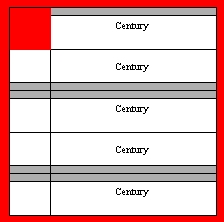 He also says that sometimes a cohort is assigned a space 150 X 150 (1.25 X 5 rows, but with 1/4 of one row empty) but that this should be avoided because it will leave part of the space empty. The illustration shows this formation. One century is split between 4 rows. The upper left corner is left empty.
When placing the cohorts along the sides of the camp Hyginus gives them spaces of 240 X 90 pedes.
The first cohort in Hyginus' time was doubled and so receives a space of 120 X 360 ( 2 X 6 rows) or 180 X 240 (4 X 3 rows) pedes.
What happens to space allotment when a century or cohort is understrength? Is the space kept the same or is it reduced? There is no definitive answer, but in paragraph 40 Hyginus talks about rows that are more tightly packed to squeeze in additional men or spaced more widely to preserve the whole layout of the camp. Since Hyginus packs the camp with cohort spaces that are uniform and fit together tightly, it would seem that the space for each century was fixed regardless of its actual size. As noted above, because the unit would always be below its nominal strength, the occupancy rates for the tents could be as low as 4 or 5 per tent, even lower if a unit suffered serious casualties. There is some slight hint in Hyginus [40] that the number of tents might not have been absolute so that, in a case such as this, the space for the century might be the same but that it might use fewer tents spaced further apart.
He also says that sometimes a cohort is assigned a space 150 X 150 (1.25 X 5 rows, but with 1/4 of one row empty) but that this should be avoided because it will leave part of the space empty. The illustration shows this formation. One century is split between 4 rows. The upper left corner is left empty.
When placing the cohorts along the sides of the camp Hyginus gives them spaces of 240 X 90 pedes.
The first cohort in Hyginus' time was doubled and so receives a space of 120 X 360 ( 2 X 6 rows) or 180 X 240 (4 X 3 rows) pedes.
What happens to space allotment when a century or cohort is understrength? Is the space kept the same or is it reduced? There is no definitive answer, but in paragraph 40 Hyginus talks about rows that are more tightly packed to squeeze in additional men or spaced more widely to preserve the whole layout of the camp. Since Hyginus packs the camp with cohort spaces that are uniform and fit together tightly, it would seem that the space for each century was fixed regardless of its actual size. As noted above, because the unit would always be below its nominal strength, the occupancy rates for the tents could be as low as 4 or 5 per tent, even lower if a unit suffered serious casualties. There is some slight hint in Hyginus [40] that the number of tents might not have been absolute so that, in a case such as this, the space for the century might be the same but that it might use fewer tents spaced further apart.
Placement of the Legionary Cohorts in the Camp
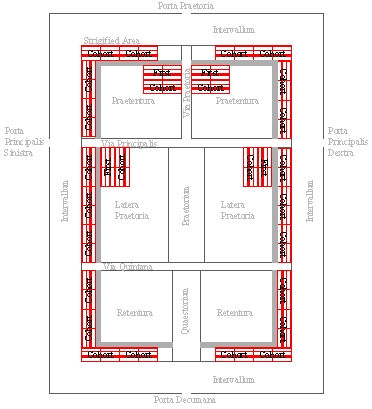 Even as late as Hyginus, the core of the Roman army was the legion and its cohorts. These were placed around the perimeter of the camp so that they both contained the other, possibly less reliable, troops and were closer to the ramparts to defend the camp in case of attack. There was probably another factor as well, the air would certainly have been fresher on the outside edges of the camp.
The camp Hyginus describes has three legions, making 30 cohorts. Four cohorts, the three double size first cohorts plus one regular cohort, are given space inside the via sagularis. One goes just inside the via sagularis and next to the via praetoria. To balance things out a regular cohort is positioned on the opposite side of the street: dextra cohors contraria tendat ut possit exercitus combinatus educi [3]. Two go next to the via sagularis on each side and just below the via principia. [3]
Paragraph [44]:
Even as late as Hyginus, the core of the Roman army was the legion and its cohorts. These were placed around the perimeter of the camp so that they both contained the other, possibly less reliable, troops and were closer to the ramparts to defend the camp in case of attack. There was probably another factor as well, the air would certainly have been fresher on the outside edges of the camp.
The camp Hyginus describes has three legions, making 30 cohorts. Four cohorts, the three double size first cohorts plus one regular cohort, are given space inside the via sagularis. One goes just inside the via sagularis and next to the via praetoria. To balance things out a regular cohort is positioned on the opposite side of the street: dextra cohors contraria tendat ut possit exercitus combinatus educi [3]. Two go next to the via sagularis on each side and just below the via principia. [3]
Paragraph [44]:
Loosely translated: There are 16 cohorts on the sides [of the camp], six in the praetentura, 4 in the retentura which are assigned a space of 60 by 360 pedes; and the remaining 4 are inside the via sagularis. By some logic that eludes us, he counts the cohorts at the ends of the camp as belonging to the praetentura and retentura, but not those along the sides. He does not give the dimensions of the 6 cohorts along the top side of the camp but, if three are to fit on each side, then they must be 90 by 240 pedes. The cohorts on the sides of the camp are clearly described as being 240 by 90 oriented with the long side parallel to the sides of the camp: et lateribus castrorum cohortibus tabulino XC [3] The only information about where individual cohorts or legions are placed comes in [18]: the name of the rear gate, the porta decumana is derived from the fact that the tenth cohorts of the legions have their tents next to it: quae a cohortibus decimis ibi tendentibus decimana est appellata. In [17] he comments that if there are 5 legions then the cohorts of the fifth legion camp in the retentura, below the via quintana, hence the name of the street. And, finally, in [4] he notes that if a cohort is crowded into a certain space that it be suo numero, that is, in order by number. This would seem to imply that the cohorts were arranged in some sort of numerical sequence, as one would expect. Beyond that, he is silent about which cohorts went where. The orientation of the cohorts along the four sides of the camp is one of the few things that is clear in the text. The description of the tent-rows and various configurations of the cohorts in [1&2] plus the specific dimensions for the cohorts in [3&44] make it clear that the tent-rows are aligned parallel to the sides of the camp. This has implications for the way in which the army could exit. The tents were so close together that the guy ropes of adjacent tents would overlap each other. The only way out of the tenting area was by the paths left between the hemistrigum as illustrated above. This seems somewhat counterintuitive. If the tent rows were perpendicular to the sides of the camp then the men could rapidly exit directly into the intervallum to defend the walls in case of attack. As it is, only the men in the outermost row of tents have direct access. All of the others have to file out between the tents to the nearest street. In some cases, this would be about 300 yards. The via sagularis runs just inside the legionary cohorts but cannot be accessed by them because their own tents obstruct their access. Nevertheless, as odd as it seems, the text of Hyginus leaves little doubt about the tent alignment. The benefit of the placement of the first cohorts is fully explained. Hyginus simply says that they are put inside the via sagularis because they have the standards for the legions: cohors prima causa signorum et aquilae intra viam sagulariam [3]. They are stationed near gates so one would assume that they led the way for their respective legions through each of the three gates they flanked. The plan above shows the arrangements of the cohorts in the camp as it is described by Hyginus. One should note that the cohorts do not fit the size of the sides of the camp exactly. There are gaps at the bottom and top of each side. Hyginus does not mention this and it is not clear what would have been done in practice to close those gaps.Erunt itaque lateribus cohortes XVI; praetendent sex, retendent quattuor cohortes et singulae sexaginta per CCCLX; reliquae quattuor cohortes intra viam sagularem.
The Praetentura
Dimensions:
Width
The key paragraph is:For the three-legion camp he is describing, half of the camp is 720 pedes wide, he says. The cohorts on the side take up 90, the via sagularis takes 30, leaving 600 pedes for the tents for the soldiers in the praetentura. In a later section, he then describes just how to calculate the number of men a tent-row 600 pedes long will hold. This implies two things. First, that the tent-rows are parallel to the via principia. And, second, that the space being discussed, the 720 pedes, is not the full half-width of the camp but is only the width between the margin of the via praetoria and the inner margin of the via sagularis. There is a problem with the numbers he gives. As noted above, he says that the camp should be 1600 pedes wide. Half would be 800. The via praetoria is 60 feet wide, half of that would be 30 pedes. The intervallum is 60 feet. Adding them to the 720 that he calls for in [32] comes to 810 feet, not 800. Therefore this is not the solution to the missing number problem. A possible solution may be the introduction of streets. In other cases, Hyginus calculates the space for tents omitting the space that streets take up (see below [35 & 36]). Therefore, the 600 pedes may represent just tent space and not include some streets. If, indeed, the rows run parallel to the via principia then the men in the centre of a row would only be able to exit by making their way between 300 pedes of tents to either the via praetoria or the via sagularis on either side. However, if there were streets running parallel to the via praetoria then the men would be able to connect with the cross streets that Hyginus mentions (described below). In that case, the dimensions would be 600 pedes for tents plus 50 pedes for streets. These small streets were either 10 or 20 pedes wide so the 50 pedes could make between 3 to 5 streets. Then the total width of the praetentura would be:Observare itaque debebimus ut, quotiens tres legiones cum supplementis acceptae fuerint, dimidia pars castrorum DCCXX pedes latitudinis habeat et lateribus castrorum cohortibus tabulino XC, signis CCXL pedes adsignemus ut deducto tabulino cohortium et latitudine viae sagularis, reliqui DC [centum] pedes supersint. [32]
Toal: 800
- 30 (half of the via praetoria)
- 600 (tents)
- 50 (3-5 streets)
- 30 (via sagularis)
- 90 (legionary cohorts)
Length
One has to go to many more paragraphs to calculate the length that Hyginus proposes. In [34] he calculates that two ala miliaria, 1,000 man cavalry units, are to go into the praetentura. The cavalryman is assigned 3 pedes of hemistrigum so that a 600 pedes row will hold 200 men. Therefore each ala will take 5 rows. The hemistrigum is 30 pedes so 5 rows will take 150 pedes. Two alae take 300. In [35 & 36] he calculates space for 4,000 infantry. They each receive 1 1/5 pedes of hemistrigum so that the 600 pedes row will hold 500 infantry. The 4,000 men, then, require 8 rows, 240 pedes. The key sentences in [36] are:There are 720 pedes, of which 540 are occupied, leaving 180. He assigns a total of 60 pedes to streets: 20 to the via vicinaria which goes behind the first cohort (and 10 each to 4 other unnamed streets. The remaining 120 pedes he divides between the scamnum of the tribunes and of the legates, giving them 60 each. A scamnum was an engineering term for a rectangle that was wider than it was tall. Both the tribunes and legates receive space 600 feet wide and 60 feet deep on each side of the camp. The length of the praetentura, therefore, is 720 feet divided into subsections for the alae, the infantry, streets and officers. Notice that in the calculations of space for the alae and infantry he did not inject the additional space for streets; they appear only as a kind of footnote at the end of the space discussion. This is possible support for supposing that, in an exactly similar way, he did not include street space in his description of the 600 foot wide rows.faciunt pedes DCCXX, ex quibus decedit quod numerus occupat, pedes DXL: reliqui pedes CLXXX quo VI hemistrigia nascuntur. Vt nunc vicinaria via super cohortem primam, item numero quattuor pedum denum: fit in vias pedes LX; reliqui pedes CXX, quod scamnis tribunorum et legatorum, singulis LX pedes, adsignabimus.
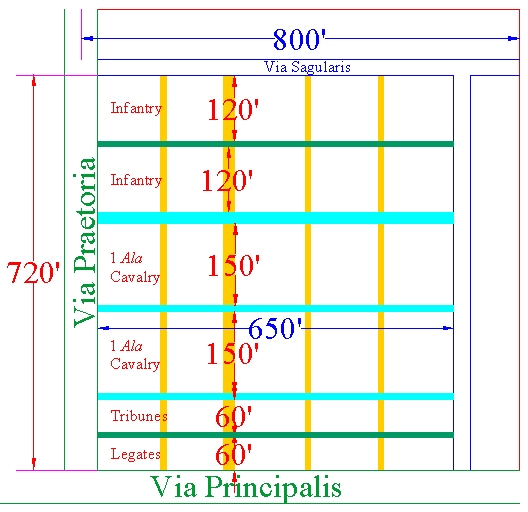
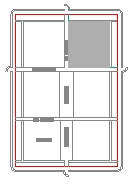 This drawing shows the layout of the praetentura as proposed above. The drawing on the left is an enlargement of the shaded area on the right. On the left, the main divisions of the praetentura are shown: Infantry, Alae, Tribunes and Legates. The length (top to bottom) of each area is shown in red. The total length of the praetentura is given on the far left, 720 pedes. The width of the praetentura is 650 pedes --the blue dimension indicator toward the bottom. The overall width of the half-camp dimension, from the middle of the via praetoria on the left to the edge of the intervallum on the right is 800 pedes (top arrow); the width Hyginus prescribed.
Five horizontal streets are shown. The three in cyan are streets whose locations and width are mentioned by Hyginus. The two in green are known to have existed and are known to have been 10 pedes wide, but the location is not specified. One is placed midway through the body of infantry, matching that separating the two alae of cavalry; the other is between the legates and tribunes.
The four vertical streets, gold coloured, are hypothetical, placed there to make up the missing space in Hyginus' description. One street is 20 pedes wide, the other three are 10 pedes.
This drawing shows the layout of the praetentura as proposed above. The drawing on the left is an enlargement of the shaded area on the right. On the left, the main divisions of the praetentura are shown: Infantry, Alae, Tribunes and Legates. The length (top to bottom) of each area is shown in red. The total length of the praetentura is given on the far left, 720 pedes. The width of the praetentura is 650 pedes --the blue dimension indicator toward the bottom. The overall width of the half-camp dimension, from the middle of the via praetoria on the left to the edge of the intervallum on the right is 800 pedes (top arrow); the width Hyginus prescribed.
Five horizontal streets are shown. The three in cyan are streets whose locations and width are mentioned by Hyginus. The two in green are known to have existed and are known to have been 10 pedes wide, but the location is not specified. One is placed midway through the body of infantry, matching that separating the two alae of cavalry; the other is between the legates and tribunes.
The four vertical streets, gold coloured, are hypothetical, placed there to make up the missing space in Hyginus' description. One street is 20 pedes wide, the other three are 10 pedes.
Content:
The types of units placed in the praetentura are not completely clear, nor are their locations. The first time he mentions it is in [4]:In [4] he begins with a mention of a camp with "5 or 6 legions": quinque vel sex legiones. But then, as he describes the sequence of units that come next to the first cohort he gives one small detail that appears to confirm that he is back to discussing a three-legion camp. In the final sentence he says: Quorum pedatura in singulas species ad homines CC solet computari: "space for the hospital, veterinary and workshops are calculated as if they had 200 men each." Later in [35] he gives more information about the space requirements for the workshops:Quotiens autem quinque vel sex legiones acceptae fuerint, binae cohortes primae lateribus praetorii tendere debebunt, duae in praetentura supra quibus valetudinaria, deinde vexillarii vel cohors secunda; et si res exiget, cohors peditata quingenaria loco vexillariorum solet superponi, et si strictior fuerit pedatura, cohorti legionariae dari debet, sed numero suo, ut CXX pedes valetudinarium et reliqua quae supra tendent accipiant, hoc est veterinarium et fabrica, quae ideo longius posita est ut valetudinarium quietum esse convalescentibus posset. Quorum pedatura in singulas species ad homines CC solet computari.
In [35] he is clearly giving dimensions for the three-legion camp, he says: cum pedatura valetudinarii, veterinarii et fabricae quae in unum ad DC homines computantur: "the space for the hospital, veterinary and workshops are calculated as if they were 600 men." The required space is 120 pedes of the hemistrigum. 600 men at 1 1/5 pedes per man require 720 pedes. If they are given 6 rows, the number used by the first cohort, then they would only need 120 pedes of the available 600 in the overall width. Therefore, somewhere between the opening phrase of paragraph [4] and the middle he switches from talking about a five or six-legion camp back to a three-legion camp. This has relevance because of the section between the two parts in which he discusses the sequence of units that should come next to the first cohort. He says the first cohorts in the praetentura would be next to a cohort of vexillarii who, he notes elsewhere, get the same space allocation as legionary cohorts because of their baggage: [5] Vexillarii legionum eandem pedaturam accipere debent quam cohors legionaria, quae ad sescentenos homines computatur, causa impedimentorum. deinde vexillarii vel cohors secunda. [5] If they also are arranged in 6 rows they would need 120 pedes of hemistrigum. The vexillarii are followed by a cohors peditata quingenaria, infantry who only receive 1 1/5 pedes for each man. In [28] he says that the cohors peditata quingenaria is comprised of 6 centuries; that would be 576 pedes of hemistrigum. Arranged in 6 rows, they require 96 pedes of the width. That leaves a bit more than the required 120 that Hyginus wants for the hospital, veterinary and workshop "ut CXX pedes valetudinarium et reliqua quae supra tendent accipiant". In [24] he mentions that the mauri equites and pannonii veredarii, who guard the advance troops who prepare the road for the marching column are also in the praetentura. Beyond this, all we have for unit types is the general mention of infantry and two alae of cavalry.Reliquum autem numerum, sicut retenturam, computemus ut sciamus similiter quot hemistrigia nascantur. Fit numerus, cum pedatura valetudinarii, veterinarii et fabricae quae in unum ad DC homines computantur, VIII. Sumimus dimidiam: fit IIII: hoc erit partis dimidiae; est DC pedum per longitudinem, quod <D> homines capiet; ut diximus peditem adiectam quintam ad pedem accipere, nihil itaque intersit an ad numerum computatum quintam partem adiciamus, an vero ex longitudine, ut nunc DC pedum, deducamus partem VI. Reliqui quingenti, tot homines capiet hemistrigium.
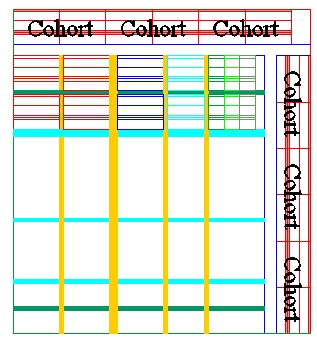 The illustration at the right shows how the units can be placed in the space available. From left to right the units are the first cohort (red), the vexillarii (blue), the cohors peditata quingenaria,(cyan) and the hospital, veterinary and workshops (shades of green). On the far right, there is a small space, 26 pedes of the width that is not unused.
Unfortunately, there is still a problem with Hyginus' plan for the praetentura. He assigns 4,000 infantry to the space, giving them 8 rows [35 & 36]. However in [3], he has already assigned the 960 men of one of the first cohorts to the praetentura. Even if one assumes that the 960 men of the first cohort are included in the 4,000 men he wants to put in the praetentura, there is still a problem.
Legionary infantry and the vexillarii are given 1 1/2 pedes of hemistrigum each [1 & 2] but when Hyginus calculates the space for the 4,000 he uses a figure of 1 1/5 pedes each [34 - 35]. That means that even if the 960 men of the first cohort were to be subtracted from the 4,000 he assigns to the praetentura, the numbers would not work out.
In the six rows of tents illustrated above, there are 960 men in the first cohort, 480 in the vexillarii, 480 in the cohors peditata quingenaria and the equivalent of 400 for the hospital, veterinary and workshops. This gives a total of 2,320 men in the 6 rows. However in [35 - 36] where Hyginus calculates the space he assigns 500 men per row, so these same 6 rows should be holding 3,000 men. Hyginus has shorted himself some 680 men.
The illustration at the right shows how the units can be placed in the space available. From left to right the units are the first cohort (red), the vexillarii (blue), the cohors peditata quingenaria,(cyan) and the hospital, veterinary and workshops (shades of green). On the far right, there is a small space, 26 pedes of the width that is not unused.
Unfortunately, there is still a problem with Hyginus' plan for the praetentura. He assigns 4,000 infantry to the space, giving them 8 rows [35 & 36]. However in [3], he has already assigned the 960 men of one of the first cohorts to the praetentura. Even if one assumes that the 960 men of the first cohort are included in the 4,000 men he wants to put in the praetentura, there is still a problem.
Legionary infantry and the vexillarii are given 1 1/2 pedes of hemistrigum each [1 & 2] but when Hyginus calculates the space for the 4,000 he uses a figure of 1 1/5 pedes each [34 - 35]. That means that even if the 960 men of the first cohort were to be subtracted from the 4,000 he assigns to the praetentura, the numbers would not work out.
In the six rows of tents illustrated above, there are 960 men in the first cohort, 480 in the vexillarii, 480 in the cohors peditata quingenaria and the equivalent of 400 for the hospital, veterinary and workshops. This gives a total of 2,320 men in the 6 rows. However in [35 - 36] where Hyginus calculates the space he assigns 500 men per row, so these same 6 rows should be holding 3,000 men. Hyginus has shorted himself some 680 men.
The Praetorium and Latus Praetorii
Dimensions:
 The width and length of the latus praetorii (grey area at left)sides of the praetorium, are easy to determine. The width is the same as the praetorium, 800 pedes from the centerline of the camp to the edge of the intervallum. The length is given in [9] where Hyginus unambiguously says that this area is 720 feet long.
The centre of the area was called the praetorium. That filled the entire area between the via principalis and the via quintana, 720 pedes. It was between 160 and 220 pedes wide. [9]
As noted above, the width from centerline to intervallum is 800 pedes. 90 are used by the cohorts on the sides of the camp and 30 by the via sagularis. That leaves 680 inside the via sagularis. If the praetorium, which spans the centerline, were 160 pedes wide [9] then half of it would be 80 pedes, leaving 600. In [33] Hyginus accounts for the 600 pedes. He gives the praetorian cohort 60, the stationi (guard stations) 20, the comites (staff and aides to the commander) 60, 420 to the soldiers and 40 to streets.
The width and length of the latus praetorii (grey area at left)sides of the praetorium, are easy to determine. The width is the same as the praetorium, 800 pedes from the centerline of the camp to the edge of the intervallum. The length is given in [9] where Hyginus unambiguously says that this area is 720 feet long.
The centre of the area was called the praetorium. That filled the entire area between the via principalis and the via quintana, 720 pedes. It was between 160 and 220 pedes wide. [9]
As noted above, the width from centerline to intervallum is 800 pedes. 90 are used by the cohorts on the sides of the camp and 30 by the via sagularis. That leaves 680 inside the via sagularis. If the praetorium, which spans the centerline, were 160 pedes wide [9] then half of it would be 80 pedes, leaving 600. In [33] Hyginus accounts for the 600 pedes. He gives the praetorian cohort 60, the stationi (guard stations) 20, the comites (staff and aides to the commander) 60, 420 to the soldiers and 40 to streets.
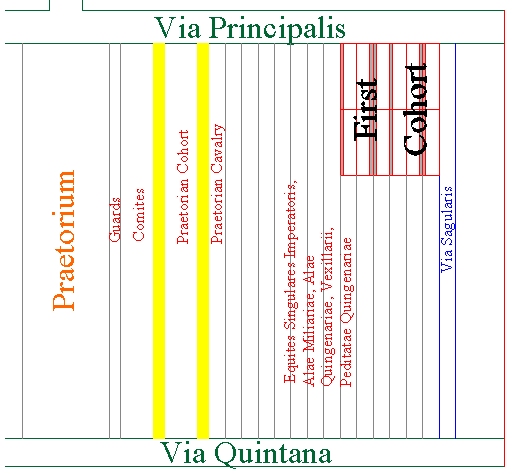 This implies that the direction of these tent-rows is perpendicular to the via principia.. (In the praetentura the tent-rows were parallel to the via principia.) This is supported by his comment in [9] that the length of the area must be 720 pedes so that the lines of the tents of the praetorian cohort could pitch its tents in unbroken lines. One cohort takes 720 pedes. The praetorian cohorts, however, get double space [6] so that instead of 30 X 720 a single cohort receives 60 X 720.
In [9] he notes that although the guard stations should get 20 pedes, they can be reduced to 10 if there is not enough space.
In [23] he lists the units: cohortes praetoriae, equites praetoriani, equites singulares imperatoris, alae miliariae or quingenariae, vexillarii and cohortes secundae or peditatae quingenariae. And, as mentioned in [3], the doubled first cohort.
In [10] Hyginus says that the comites should get 50 to 70 feet. In [33] he actually allots them 60.
There is a street between the comites and the praetorian cohorts [10] and another between them and the rest of the troops. [39]
The apparent sequence of the units is guards immediately next to the praetorium [9], then the comites followed by a road. Then the praetorian cohorts, the praetorian cavalry on one side, the equites singulares on the other, then the alae and, if there is space, some units of vexillarii and peditate. The first cohort occupies the corner bordered by the via principia and the via sagularis.
The praetorium is not well described. In [10] he mentions that there is an altar and an auguratorium at the end nearest the via principia. Other sources place the commanders tent in the center 1/3 of the area and set the last 1/3 aside as the posticum (the Latin word for back).
This implies that the direction of these tent-rows is perpendicular to the via principia.. (In the praetentura the tent-rows were parallel to the via principia.) This is supported by his comment in [9] that the length of the area must be 720 pedes so that the lines of the tents of the praetorian cohort could pitch its tents in unbroken lines. One cohort takes 720 pedes. The praetorian cohorts, however, get double space [6] so that instead of 30 X 720 a single cohort receives 60 X 720.
In [9] he notes that although the guard stations should get 20 pedes, they can be reduced to 10 if there is not enough space.
In [23] he lists the units: cohortes praetoriae, equites praetoriani, equites singulares imperatoris, alae miliariae or quingenariae, vexillarii and cohortes secundae or peditatae quingenariae. And, as mentioned in [3], the doubled first cohort.
In [10] Hyginus says that the comites should get 50 to 70 feet. In [33] he actually allots them 60.
There is a street between the comites and the praetorian cohorts [10] and another between them and the rest of the troops. [39]
The apparent sequence of the units is guards immediately next to the praetorium [9], then the comites followed by a road. Then the praetorian cohorts, the praetorian cavalry on one side, the equites singulares on the other, then the alae and, if there is space, some units of vexillarii and peditate. The first cohort occupies the corner bordered by the via principia and the via sagularis.
The praetorium is not well described. In [10] he mentions that there is an altar and an auguratorium at the end nearest the via principia. Other sources place the commanders tent in the center 1/3 of the area and set the last 1/3 aside as the posticum (the Latin word for back).
The Quaestorium and Retentura
The third area of the camp was called the retentura. At its centre, it had a large open space called the quaestorium.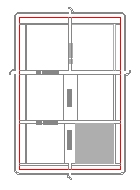 Hyginus observes that the name, quaestorium, originally referred to the second-highest officer, the quaestor, in the days of the republic [18]. In his day the space was used to house captives, hostages and booty.
On the sides of the quaestorium were a century of the statores, then a cohors peditata quingenaria or equitata. Beyond them are more cohors peditata and a variety of national units. [19] Hyginus adds an interesting note in [19]: et per reliquas strigas cohortes peditatae vel equitatae ad viam quintanam spectare debebunt: "The lines of tents of the rest of the rows, whether foot soldiers or mounted, should look toward the via quintana." Thus it appears that the first several units are lined up parallel to the side of the quaestorium -- that is, perpendicular to the via quintana, and the rest are lined up parallel to it.
In [31] and [42] Hyginus lists the number of men to be placed in the retentura, 6820. He places them in 17 rows and puts 400 men in each row. The 400 men take up 480 pedes of space in the row. 17 rows, at 30 pedes per row would make a rectangle 480 X 520 pedes.
Hyginus observes that the name, quaestorium, originally referred to the second-highest officer, the quaestor, in the days of the republic [18]. In his day the space was used to house captives, hostages and booty.
On the sides of the quaestorium were a century of the statores, then a cohors peditata quingenaria or equitata. Beyond them are more cohors peditata and a variety of national units. [19] Hyginus adds an interesting note in [19]: et per reliquas strigas cohortes peditatae vel equitatae ad viam quintanam spectare debebunt: "The lines of tents of the rest of the rows, whether foot soldiers or mounted, should look toward the via quintana." Thus it appears that the first several units are lined up parallel to the side of the quaestorium -- that is, perpendicular to the via quintana, and the rest are lined up parallel to it.
In [31] and [42] Hyginus lists the number of men to be placed in the retentura, 6820. He places them in 17 rows and puts 400 men in each row. The 400 men take up 480 pedes of space in the row. 17 rows, at 30 pedes per row would make a rectangle 480 X 520 pedes.
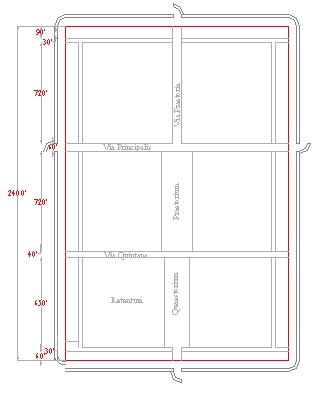 Hyginus does not give the overall dimensions of the retentura and its components but it may be possible to calculate them. Hyginus says the camp was 2600 pedes long. We know all of the lengths except the quaestorium. Starting at the top of the camp they are: 1 row of legionary cohorts, 90; via sagularis; 30, praetentura, 720; via principia, 60; praetorium, 720; via quintana, 40. This totals to 1,660 pedes. At the bottom of the camp, there is a line of legionary cohorts, this time is a shallower formation, only 60 pedes deep, and another branch of the via sagularis, 30. That leaves 650 pedes available for the length of the retentura.
The width of the camp, from centerline to the edge of the intervallum was 800 pedes. The quaestorium is narrower than the praetorium, which is 160 pedes wide, so that the guards can be closer to the posticum.
Hyginus does not give the overall dimensions of the retentura and its components but it may be possible to calculate them. Hyginus says the camp was 2600 pedes long. We know all of the lengths except the quaestorium. Starting at the top of the camp they are: 1 row of legionary cohorts, 90; via sagularis; 30, praetentura, 720; via principia, 60; praetorium, 720; via quintana, 40. This totals to 1,660 pedes. At the bottom of the camp, there is a line of legionary cohorts, this time is a shallower formation, only 60 pedes deep, and another branch of the via sagularis, 30. That leaves 650 pedes available for the length of the retentura.
The width of the camp, from centerline to the edge of the intervallum was 800 pedes. The quaestorium is narrower than the praetorium, which is 160 pedes wide, so that the guards can be closer to the posticum.
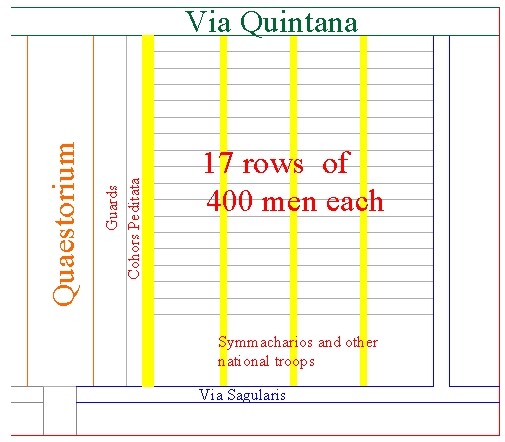 The guards are given 20 pedes of width. With no other evidence, it is reasonable to make the quaestorium smaller by 20 pedes on a side, or 120 pedes. From the centerline, it would take up 60 pedes. The guards are 20 pedes, a cohors peditata would normally be given 30. After this unit, the orientation of the tent rows appears to shift by 90 degrees. Therefore a street would be logical, say another 20 pedes. This brings the total to 130 to this point. As we say in the section on the praetentura above, there are 680 pedes from the centerline to the intervallum. 680 less 130 equals 550 pedes of width left. The troops Hyginus describes in [31] and [42] take up a rectangle 480 X 520. Since the rows (480 pedes long) are parallel to the via quintana this is the measure across the width of the camp. There are 70 pedes unaccounted for. Some could be taken up in streets. But there is another possibility.
In [19] Hyginus says: lateribus eiusdem [the quaestorium] tendere debent ad viam quintanam centuriae statorum ut posticum praetorii tueantur et proximi sint praetorium; quibus duplam pedaturam adsignabimus quod eisdem tentoriis utantur quibus cohortes praetoriae: "the statores are given double space because they use the same larger tents as the praetorian cohorts." If the guards next to the quaestorium were given the same space as the praetorian cohorts they would get 60 pedes of space. The 70 pedes of unaccounted-for space would then be divided, 40 to the guards and 30 to streets; a quite reasonable allocation. This space allocation is not to be confused with the stationi next to the praetorium which is only given 20 pedes of space [33] and in [9] he says they can get by with 10. Stationi probably means guard stations - the places along the sides of the praetorium where the statores who were housed along the quaestorium acutally stood their watches.
The depth of the retentura is 650 pedes. The block of men Hyginus assigns to the space is 480 pedes wide by 520 deep. That leaves 130 pedes of the depth.
In [43] Hyginus says that the Symmacharios and other national troops are to be distributed among the lines. These units should not be broken up into more than three parts and they should be placed near each other. It at least seems possible that these troops are different from the 6,820 men he puts into the 17 rows in paragraph [31] and [42]. If so, then they could be placed in the open space.
The illustration above shows the retentura as described. The first street, behind the cohors peditata is attested by Hyginus, the other three are speculative. It is entirely possible that there would also have been cross streets. If so, then the space for the symmacharios at the bottom would be correspondingly reduced.
The guards are given 20 pedes of width. With no other evidence, it is reasonable to make the quaestorium smaller by 20 pedes on a side, or 120 pedes. From the centerline, it would take up 60 pedes. The guards are 20 pedes, a cohors peditata would normally be given 30. After this unit, the orientation of the tent rows appears to shift by 90 degrees. Therefore a street would be logical, say another 20 pedes. This brings the total to 130 to this point. As we say in the section on the praetentura above, there are 680 pedes from the centerline to the intervallum. 680 less 130 equals 550 pedes of width left. The troops Hyginus describes in [31] and [42] take up a rectangle 480 X 520. Since the rows (480 pedes long) are parallel to the via quintana this is the measure across the width of the camp. There are 70 pedes unaccounted for. Some could be taken up in streets. But there is another possibility.
In [19] Hyginus says: lateribus eiusdem [the quaestorium] tendere debent ad viam quintanam centuriae statorum ut posticum praetorii tueantur et proximi sint praetorium; quibus duplam pedaturam adsignabimus quod eisdem tentoriis utantur quibus cohortes praetoriae: "the statores are given double space because they use the same larger tents as the praetorian cohorts." If the guards next to the quaestorium were given the same space as the praetorian cohorts they would get 60 pedes of space. The 70 pedes of unaccounted-for space would then be divided, 40 to the guards and 30 to streets; a quite reasonable allocation. This space allocation is not to be confused with the stationi next to the praetorium which is only given 20 pedes of space [33] and in [9] he says they can get by with 10. Stationi probably means guard stations - the places along the sides of the praetorium where the statores who were housed along the quaestorium acutally stood their watches.
The depth of the retentura is 650 pedes. The block of men Hyginus assigns to the space is 480 pedes wide by 520 deep. That leaves 130 pedes of the depth.
In [43] Hyginus says that the Symmacharios and other national troops are to be distributed among the lines. These units should not be broken up into more than three parts and they should be placed near each other. It at least seems possible that these troops are different from the 6,820 men he puts into the 17 rows in paragraph [31] and [42]. If so, then they could be placed in the open space.
The illustration above shows the retentura as described. The first street, behind the cohors peditata is attested by Hyginus, the other three are speculative. It is entirely possible that there would also have been cross streets. If so, then the space for the symmacharios at the bottom would be correspondingly reduced.
The Military Units in Hyginus' Army
Units listed in [30]
Hyginus lists the units and their numbers in [30].Neither of the two translations is completely satisfactory. DeVoto:. . . legiones III; vexillarii MDC; cohortes praetoriae IIII; equites praetoriani CCCC; equites singulares imperatoris CCCCL; alae miliariae IIII, quingenariae V; Mauri equites DC; Pannonii veredarii DCCC; classici Misenates D, Ravennates DCCC; exploratores CC; cohortes equitatae miliariae II, quingenariae IIII; cohortes peditatae miliariae III, quingenariae III; Palmyreni D, Getuli DCCCC, Daci DCC, Brittones D, Cantabri DCC; centuriae statorum II. [30]
Richmond:We will thus compute the allotted totals which are written below: 3 legions, 1600 banner-carriers, 4 praetorian cohorts, 400 praetorian horsemen, 450 elite horsemen of the emperor, four 1000-horse wings, five 500-horse [wings], 600 Moorish horsemen, 800 swift Pannonian riders, 500 Misenian and 800 Ravennian soldiers of the fleet, 200 scouts, two 1000-man mounted cohorts, three 500-man ones, 500 Palmyrenes, 900 Gaetulians, 700 Dacians, 500 Britons, 700 Cantabrians and 2 centuries of vigiles.
The Richmond translation is jumbled and the Miller/DeVoto translation leaves out the cohortes peditatae miliariae III and quingenariae III. The types of units are described below, followed by a table showing the total number of men in the army.Given the numbers written above we calculate as follows. 3 legions, 1500 long-service men 1600 vexillarii, 4 praetrorian cohorts, 400 praetorian cavalry, 450 IMPERIAL Horse Guards, 4 alae milliariae, 5 alae quingenariae, 600 Moorish cavalry, 800 Pannonian Hussars 800 Pannonian veredarii, 500 marines from Misenum, 800 from Ravenna, 320 mounted police, 200 scouts (speculatores. These troops combined police and courier duties, so many were provided by each legion. There was a head office in Rome. I.A.R), two large cohorts of mounted infantry 2 cohortes equitatae milliariae, for small ones 4 equitatae quingenariae, three large cohorts 3 cohortes peditatae milliariae, three small ones 3 cohortes quingenariae, 500 Palmyreni, 900 Gaesati, 700 Dacians, 500 Britons, 700 Cantabri, two centuries of guards statores.
- Legiones III -- three legions: at nominal strength, the legions are comprised of 10 cohorts of 6 centuries each, with 80 men to the century, but with a doubled first cohort: 5,280 men. Plus 180 centurions. The number of tribunes is not specified but they were usually 6, and one legate per legion.
- Vexillarii MDC -- 1600 vexillarii: Officers for them are not described but if they were organized along the lines of the legionary infantry there would be 20 centurions and presumably a commander. The term vexillarii occurs numerous times in the document. Miller/DeVoto translate it as "banner-carriers." Richmond translates it as "long-service men." Dobson does not translate the term. Neither of these translations is good. According to the Lewis & Short Latin Dictionary the word has two meanings: 1. "a standard-bearer", 2. "in the times of the emperors, the oldest class of veterans, the last summoned." Standard-bearer is misleading. 'Banner-carrier' is better. The vexilla was a small flag used to identify the legion, the cavalry alae, possibly cavalry turmae, detached units and possibly the various national units Hyginus mentions. If each of these had one vexillarius. There would only be 42 of them. Besides the vexillarius there was the signifer who carried the standards, the imaginarius who carried the image of the emperor and the draconarius who carried the draco. Even if Hygiinus used the word in a generic sense to include all of the standard-bearers there might be at most a few hundred. Certainly not the 1,600 that Hyginus specifies in [30]. Therefore the term is better translated by the second meaning: a detachment of veterans.
- Cohortes Praetoriae IIII -- 4 praetorian cohorts (guards for the emperor). They are mentioned in: [6, 8, 9, 10, 19, 23 & 30]. In [9] he assigns them 720 pedes of hemistrigium but notes that they receive twice the space of a regular infantry contubernium because their tents are larger. He does not mention officers. Without information to the contrary, these cohorts can be counted the same as legionary cohorts: 480 men per cohort, one centurion for each 80 man century, a commander.
- Equites Praetoriani CCCC -- 400 Praetorian cavalry. [7, 8, 23 & 30] Hyginus does not describe the makeup of these units. He does note that the number can be variable but in [30] gives a figure of 400.
- Equites Singulares Imperatoris CCCCL -- 450 equites singulares imperatoris. Miller/DeVoto: "elite horsemen of the emperor." Richmond: "imperial horse guards."
- Alae Miliariae IIII -- four 1,000-man cavalry regiments. in [16] he notes that they are comprised of 24 turmae, totaling 1,000 men. He also mentions the officers: decurio, duplicarii and sesquiplicarii and says there was one each per turma. He then calculates the extra horses they require, giving the decuriones 3 each and the other two officers 2 each. The total number of horses for these 72 officers would be 168. Hyginus notes that over and above the 1,000 horses for the unit there are 96 extra horses. This means that one of the horses for the 72 officers are included in the 1,000 horses. Therefore, the officers are a part of the 1,000 man count.
- (Alae) Quingenariae V -- five 500-man cavalry units. In [16] he notes that they have 16 turmae. 16 is 2/3 of 24. If the turmae were the same size then this unit would have about 650 men, not 500. The name is possibly archaic, a hangover from an earlier unit configuration. Again, the horse-count confirms that officers are a part of the 650.
- Mauri Equites DC -- 600 Moorish cavalry.
- Pannonii Veredarii DCCC -- 800 Pannonian veredarii: Miller/DeVoto: swift Pannonian riders Richmond: Pannonian Hussars. Lewis & Short: give the meaning of veredarius as courier in late Latin.
- Classici Misenates D -- 500 of the Misenum fleet: Miller/DeVoto: Misenian soldiers of the fleet. Richmond: marines from Misenum. Lewis & Short render classici in the military sens as "of or belonging to the fleet."
- Ravennates DCCC -- 800 of the Ravenna fleet: Miller/DeVoto: Ravennian soldiers of the fleet. Richmond: marines from Ravenna
- Exploratores CC -- 200 scouts
- Cohortes Equitatae Miliariae II -- 2 cohortes equitatae milliariae: Miller/DeVoto: 1000-man mounted cohort. In [26] he gives their numbers as 240 horse, 760 infantry.
- (Cohortes Equitatae) Quingenariae IIII -- 4 cohortes equitatae quingenariae. Miller/DeVoto: 500-man mounted cohort. In [27] Hyginus gives the numbers as 120 horse 380 foot.
- Cohortes Peditatae Miliariae III -- 3 cohortes peditatae milliariae: In [28] the unit is described as having 10 centuries. That would give it a total of 800 men.
- (Cohortes Peditatae) Quingenariae III -- 3 cohortes quingenariae. In [28] he says it has 6 centuries -- 480 men.
- Palmyreni D -- 500 Palmyrenes
- Getuli DCCCC -- 900 Gaetulians
- Daci DCC -- Miller/DeVoto: Dacians
- Brittones D -- 500 Britons. Richmond adds a note to the end of his translation discussing the dating of the document. In it he says "we know the first appearance of these British units coincides with the Caledonian activity of Antonius Pius in AD 142-5." Richmond also notes that the Palmyrenes could not have been recruited after 273 so he places that as an outside date for Hyginus. However, as noted above, the praetorian guard was disbanded even earlier, in 193, so Hyginus would have been writing between 142 and 193.
- Cantabri DCC -- 700 Cantabrians
- Centuriae Statorum II -- 2 centuries of statores. Miller/DeVoto: vigiles. The statores were guards. 2 centuries would be 160 men plus 2 centurions.
Others, not listed in [30]
-
Hospital, Veterinary, Workshops: In [4] and [35] Hyginus mentions the valetudinarium hospital, veterinarium veterinary and fabrica workshops: ...ut CXX pedes valetudinarium et reliqua quae supra tendent accipiant, hoc est veterinarium et fabrica, quae ideo longius posita est ut valetudinarium quietum esse convalescentibus posset. Quorum pedatura in singulas species ad homines CC solet computari. [4]
Reliquum autem numerum, sicut retenturam, computemus ut sciamus similiter quot hemistrigia nascantur. Fit numerus, cum pedatura valetudinarii, veterinarii et fabricae quae in unum ad DC homines computantur, VIII. Sumimus dimidiam: fit IIII: hoc erit partis dimidiae; est DC pedum per longitudinem, quod <D> homines capiet; ut diximus peditem adiectam quintam ad pedem accipere, nihil itaque intersit an ad numerum computatum quintam partem adiciamus, an vero ex longitudine, ut nunc DC pedum, deducamus partem VI. Reliqui quingenti, tot homines capiet hemistrigium. [35]
All three can be considered together since Hyginus does not distinguish between them in terms of either the space assigned to them or the number of men. In [4] he notes that they each are assigned space as if they were comprised of 200 men. Then, in [35] when talking about the half-camp he notes that their space is computed at 600 men (3 X 200). Since his camp is symmetrical, there would be the same numbers on the other side. Hyginus tells us that the space is computed as if there were 200 men in each of the units -- "man-equivalents". He does not tell us precisely how many men there actually are.- Hospital: The simplest approach would be to assume that the hospital had space for 200 patients. However that may be a bit too simplistic. Space for 200 men, at the standard 8 men to the tent, would represent space for 25 tents. If there were 3 tents for the medical staff there would be 22 tent spaces for patients. However, in other places he notes that praetorians were given double space because of the size of their tents. This space may have been required because of the height of the tent as much as the square footage -- a tent with higher side walls needs more space along the sides for the guy ropes that hold it up. One would expect that a hospital tent would likewise be taller -- tall enough to walk around in. If the hospital tents were double sized there would be 11 patient tents. It would be necessary to leave some room for the doctors to care for the patients so that a tent might only hold 6 men instead of the normal 8. At that rate, the hospital unit would have space for 88 men. Since there is a hospital on each side, the 40,000 man army has hospital beds for 176 men. This is an alarmingly low ratio. Other modern sources indicate much higher ratios.
- Veterinary: Space for 200 men along the hemistrigum is being computed at the rate of 1 1/5 pedes per man. That means that the veterinary unit occupies a space 30 pedes by 240 pedes. But 6 pedes of each hemistrigum must be left open for the movement of troops, so the usable space is only 24 X 240. One would not assume that sick or injured horses were sheltered in tents. Rather, they more likely have a smallish stall space. With room allowed for the veterinarians to move around the horses, each horse could be assigned a space as small as 6 pedes by 15 pedes. That would allow 4 rows of 16 stalls. 64 horses could be cared for in each of the two veterinary spaces.
- Workshops: they would also have usable space of 24 X 240 pedes. There would be some significant numbers of carpenters, blacksmiths, leather workers and other skilled craftsmen needed to maintain the army. Just how their workshops would be arranged and what the numbers and types of craftsmen there might be is not known.
-
Primipilares: The Primipilares were the senior centurions of the legion and, as such, would not necessarily require special mention. However, in [6] Hyginus singles them out: Cohortes praetoriae lateribus praetorii tendere debent et duplam pedaturam recipere quod tentoriis maioribus utantur. Primipilares etiam et evocati in eadem pedatura locum accipiunt. [6]
- Depending on just how in eadem pedatura is interpreted, the primipilares may not have camped with their centuries. In [1] he makes the case for the centurions being tented right with their centuries. If this is where the primipilares were then why does Hyginus single them out for special mention again in [6]? Since he does, the text may mean that the primipilares had tenting space in the same area as the first cohort but apart from the regular tenting areas of the centuries.
- Evocati: The evocati are also mentioned in [6] but are not mentioned anywhere else in the text. Evocati and vexillarii both refer to veterans called back into service, but the vexillarii are clearly given space elsewhere in the camp so Hyginus must draw some distinction between the two terms. He does not include the evocati in the list of units in [30] nor does he give any further information about them.
- Comites Imperatoris: One of the definitions of comites by Lewis & Short: "After the time of the emperors, the imperial train, the courtiers, court." Hyginus allows space for the comites imperatoris in the camp but does not list them in [30] or give numbers for them. He gives them a significant amount of space, two rectangles 60 X 720 pedes. This would be enough space for 1,920 legionary infantry or 2,400 provincial infantry. Certainly the emperor's court had large tents and spacious grounds, but even so, there must have been a large number of courtiers and servants to merit such a large space.
- Hostium, Obsides & Praeda: In [18] Hyginus mentions that captives (hostium), hostages (obsides) and plunder (praeda) would be kept in the quaestorium but does not further elaborate.
- Symmacharios et reliquas nationes : [43] The allies and other national troops: are placed in the retentura. They should not be divided into more than three separate units and should all be close to one another so that they can hear the signals in their own languages.
- Baggage Train: A far more serious problem is that Hyginus does not mention or allow space for servants and the pack train. For an army of this size, the total number of servants would probably be around 10,000. There would be a similar number of mules as well. About 2/3 of the servants and 1/3 of the mules could be assigned space with the troops, for the rest, additional space within the camp would need to be allocated.
Summary
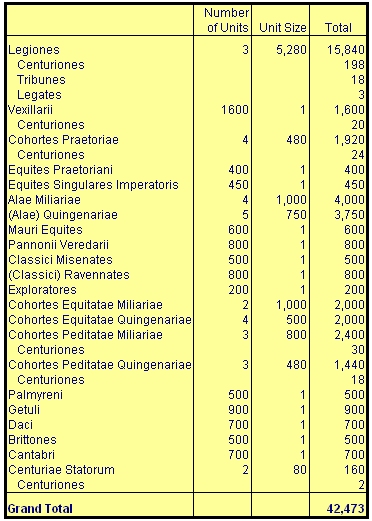 The table on the right shows a summary of the units and numbers in [30]. Where the numbers are known, it includes additional entries for their officers. In other cases, the officers are either not known or are thought to be included in the count.
This is a sizeable army, some 42 thousand fighting men. For comparison, the "Generic Army" used in some of the models for this webpage has about 30,000 fighting men.
The actual number of men in a camp for this size fighting force would be on the order of 50,000 -- a fair-sized city.
The table on the right shows a summary of the units and numbers in [30]. Where the numbers are known, it includes additional entries for their officers. In other cases, the officers are either not known or are thought to be included in the count.
This is a sizeable army, some 42 thousand fighting men. For comparison, the "Generic Army" used in some of the models for this webpage has about 30,000 fighting men.
The actual number of men in a camp for this size fighting force would be on the order of 50,000 -- a fair-sized city.
Problems with the Hyginus Camp Description
There are many difficulties with the description of the camp given by Hyginus. Some of them have already been noted, a few more are noted here. Organization: As one reads and re-reads his text it becomes clear that the content is not well organized, nor complete, nor even internally consistent. Descriptions of areas of the camp are not organized into blocks of paragraphs but are scattered throughout the document -- as can be seen from the paragraph references. Although he is thought to be an engineer, one charged to actually set up these camps, he does not present the technical data with the clarity that one would expect from an engineer. In several cases, his numbers do not work out well, not what one would hope for from an engineer, a 'numbers-man.' But then, one should, perhaps, not blame Hyginus without at least a caution that the original text undoubtedly suffered at the hands of copyists over the centuries. Unit Size: The camp Hyginus describes is based on nominal strength units. However, all armies at all times appear to have been understrength from the moment they are formed. Recruitment numbers are not filled, at any given time some men are sick, there are injuries and even deaths in training, and once the unit goes into action there are casualties of war. A unit could be anywhere from 90% to 50% of its nominal strength. The actual manpower of the 80 man century could be as low as 40 men. Hyginus says that if the actual numbers are a little less than the nominal size for the unit then the unit camps further apart and still gets the same amount of space so that the alignment of the whole camp is not thrown off, [7, 40, 41]. Space allocation: There seems to be a problem with Hyginus' allocation of space. The infantry cohorts, as noted, are assumed to have enough men on watch so that the century only needs 8 tents and the centurion pitch his tent within the century's space allowance. But the number of men on watch that Hyginus lists is insufficient to reduce the century's size by even one tent. Hyginus implicitly does the same thing when he describes other units. He either does not mention officers or includes them in the count of the men when he calculates the space requirements. Baggage Train: A serious omission in his camp model is the absence of any provision for the army's baggage train. There would have been supplies of extra weapons, armour, clothing and artillery pieces. There would be tons of food and fodder. There would be carts and wagons, perhaps many. At times there could be live cattle as part of the food supply. All of the equipment and provisions carried on pack animals had to be stacked and stored under shelter at night. A 3 legion army would have thousands of pack or draft animals and thousands of servants to handle them. Types of Units: The model he presents probably does not represent a real army but only a kind of representational force that can serve to highlight his new method of calculating space. In doing so his interest is clearly in assigning space to the military units and in showing how he can make adjustments as the size or character of the army changes. He is simply not interested in the mundane task of describing the stabling of the mules and oxen. This limits his usefulness in trying to understand a real Roman camp. One is left to speculate about the arrangements for the baggage train with absolutely no help from Hyginus. Signa: In [14] he saysMiller/DeVoto translate this phrase: "[The Praetorian Avenue] should be 60 feet in width, as above. The lanes further up in the forward tenting area along the line of tents are not parallel [to it] because their short sides will have to face the Praetorian Avenue." Richmond translates it: "[The Praetorian Avenue] must be sixty feet wide as above, because the lines of tents arranged beyond must not project in front of the praetorium, since the standards should look along the via praetoria." The difference between the two versions hinges on one's interpretation of the word signum. In military terms, it usually refers to the standards of the legion. However, in Hyginus it is only clearly used in that sense once, in [3]. Seven times it is used in another sense, as a technical term. In each of those 7 instances it is used as a paired term: signis -- tabulino. These are technical terms referring to the short and long sides of a rectangle. The question is, which meaning applies in [14]. Percurrere means to run through, pass through, traverse, run over (Lewis & Short). For Miller/DeVoto non percurrunt is taken to mean not parallel. For Richmond it is taken to mean not projecting in front of. It is known that the standards were collected at the centre of the camp. The technical term signis is always used in conjunction with tabulino in other instances, and always with the assignment of pedes to it. The Miller/DeVoto translation ignores the term propter, "because". The text says that the street must be 60 feet wide because the line of tents in praetentura non percurrunt. Inserting the Miller/DeVoto translation this becomes: " . . .because the lanes further up in the forward tenting area along the line of tents are not parallel to it." This hardly makes sense. All things considered, the Richmond interpretation seems better. Streets and exit routes: The model does not specify the number or locations of the small streets, viae vicinariae. In some cases there are some pedes that are not specified for other purposes that one can surmise were used for streets. In the latus praetorii Hyginus uses the full 720 pedes for the tents of the troops, leaving no extra pedes for streets. Given the layout of the tent rows, cross-streets would be important for the movement of the troops. They should be there, but this is one area in which Hyginus' numbers do not work that well. Doubts: Even details that Hyginus provides are somewhat suspect. For example, the orientation of the tent-rows shifts from longitudinal to latitudinal between parts of the camp and even within the retentura with such unconcern and lack of explanation that one wonders if it is simply a matter of carelessness or of error introduced by copyists. There is no way to know.latitudine, ut supra, pedum LX, propter quam rigore tensurae suae superiores strigae in praetentura non percurrunt, quoniam ad viam praetoriam signa spectare debebunt.
Conclusion
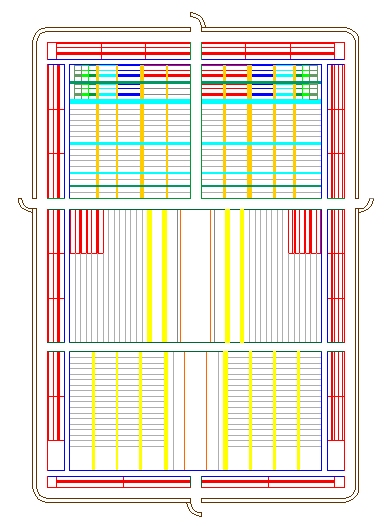 Despite the difficulties, Hyginus is the best and most complete source we have for the camp of the cohort army. The illustration shows the camp layout as well as it can be deciphered from the Hyginus document. Some of the key elements are listed below.
Aspects considered reliable:
Despite the difficulties, Hyginus is the best and most complete source we have for the camp of the cohort army. The illustration shows the camp layout as well as it can be deciphered from the Hyginus document. Some of the key elements are listed below.
Aspects considered reliable:
- The placement of the legionary cohorts outside of the via sagularis.
- The orientation of the tent rows. (Even though this may be suspect, we have no data to the contrary).
- The streets in the praetentura. (As the most accurately described street system it should probably be considered representative of the street arrangement in the other two sections of the camp as well.)
- The relative widths of the praetorium and quaestorium.
- The placement of the alae in the praetentura first and then the excess in other areas.
- The pedes on the hemistriga given to the types of soldiers: legionary infantry, 1.5, legionary cavalry, 3, provincial infantry, 1.2, and provincial cavalry, 2.5
- The location of the statores, guards, and praetorian guards near the praetorium.
- The general layout in a 2:3 proportion.
- The dimensions of the major streets and gates.
- The lengths of the praetentura and praetorium.
- The widths of the gates.
- The width of the intervallum.
- The fortifications.
- The absence of cross streets.
- The exact number of men in each area (The numbers do not always work out.)
- Space for equipment, draft and pack animals, and carts and wagons in the baggage train.
- Accommodations for servants.

